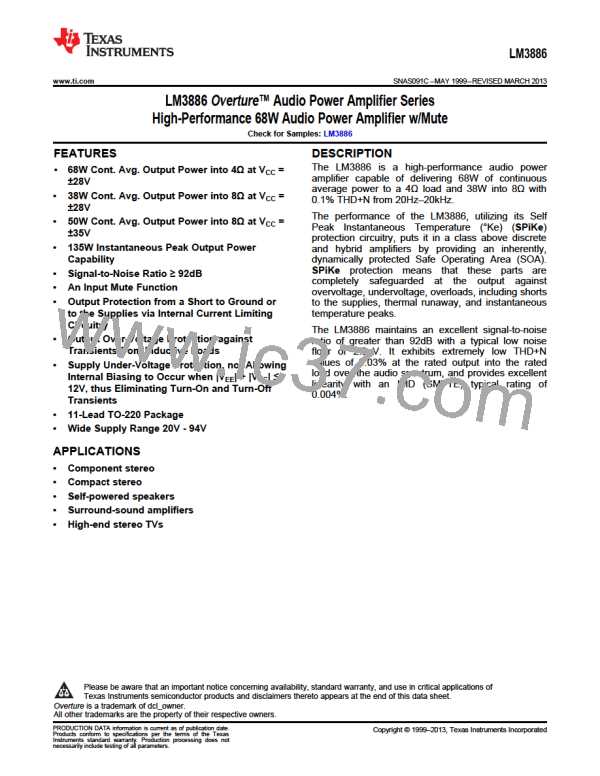LM3886
SNAS091C –MAY 1999–REVISED MARCH 2013
www.ti.com
As a benefit to the system designer we have provided Figure 34 for various loads in Typical Performance
Characteristics, giving an accurate figure for the maximum thermal resistance required for a particular amplifier
design. This data was based on θJC = 1°C/W and θCS = 0.2°C/W. We also provide a section regarding heat sink
determination for any audio amplifier design where θCS may be a different value. It should be noted that the idea
behind dissipating the maximum power within the IC is to provide the device with a low resistance to convection
heat transfer such as a heat sink. Therefore, it is necessary for the system designer to be conservative in his
heat sink calculations. As a rule, the lower the thermal resistance of the heat sink the higher the amount of power
that may be dissipated. This is of course guided by the cost and size requirements of the system. Convection
cooling heat sinks are available commercially, and their manufacturers should be consulted for ratings.
Proper mounting of the IC is required to minimize the thermal drop between the package and the heat sink. The
heat sink must also have enough metal under the package to conduct heat from the center of the package
bottom to the fins without excessive temperature drop.
A thermal grease such as Wakefield type 120 or Thermalloy Thermacote should be used when mounting the
package to the heat sink. Without this compound, thermal resistance will be no better than 0.5°C/W, and
probably much worse. With the compound, thermal resistance will be 0.2°C/W or less, assuming under 0.005
inch combined flatness runout for the package and heat sink. Proper torquing of the mounting bolts is important
and can be determined from heat sink manufacturer's specification sheets.
Should it be necessary to isolate V− from the heat sink, an insulating washer is required. Hard washers like
beryluum oxide, anodized aluminum and mica require the use of thermal compound on both faces. Two-mil mica
washers are most common, giving about 0.4°C/W interface resistance with the compound.
Silicone-rubber washers are also available. A 0.5°C/W thermal resistance is claimed without thermal compound.
Experience has shown that these rubber washers deteriorate and must be replaced should the IC be
dismounted.
Determining Maximum Power Dissipation
Power dissipation within the integrated circuit package is a very important parameter requiring a thorough
understanding if optimum power output is to be obtained. An incorrect maximum power dissipation (PD)
calculation may result in inadequate heat sinking, causing thermal shutdown circuitry to operate and limit the
output power.
The following equations can be used to accurately calculate the maximum and average integrated circuit power
dissipation for your amplifier design, given the supply voltage, rated load, and output power. These equations
can be directly applied to Figure 35 in Typical Performance Characteristics.
Equation 2 exemplifies the maximum power dissipation of the IC and Equation 3, Equation 4 exemplify the
average IC power dissipation expressed in different forms.
PDMAX = VCC2/2π2RL
where
•
VCC is the total supply voltage
(2)
(3)
(4)
PDAVE = (VOpk/RL)[VCC/π − VOpk/2]
where
•
VCC is the total supply voltage and VOpk = VCC/π
PDAVE = VCC VOpk/πRL − VOpk2/2RL
where
•
VCC is the total supply voltage
Determining the Correct Heat Sink
Once the maximum IC power dissipation is known for a given supply voltage, rated load, and the desired rated
output power the maximum thermal resistance (in °C/W) of a heat sink can be calculated. This calculation is
made using Equation 6 and is based on the fact that thermal heat flow parameters are analogous to electrical
current flow properties.
It is also known that typically the thermal resistance, θJC (junction to case), of the LM3886 is 1°C/W and that
using Thermalloy Thermacote thermal compound provides a thermal resistance, θCS (case to heat sink), of about
0.2°C/W as explained in Heat Sinking.
18
Submit Documentation Feedback
Copyright © 1999–2013, Texas Instruments Incorporated
Product Folder Links: LM3886

 TI [ TEXAS INSTRUMENTS ]
TI [ TEXAS INSTRUMENTS ]